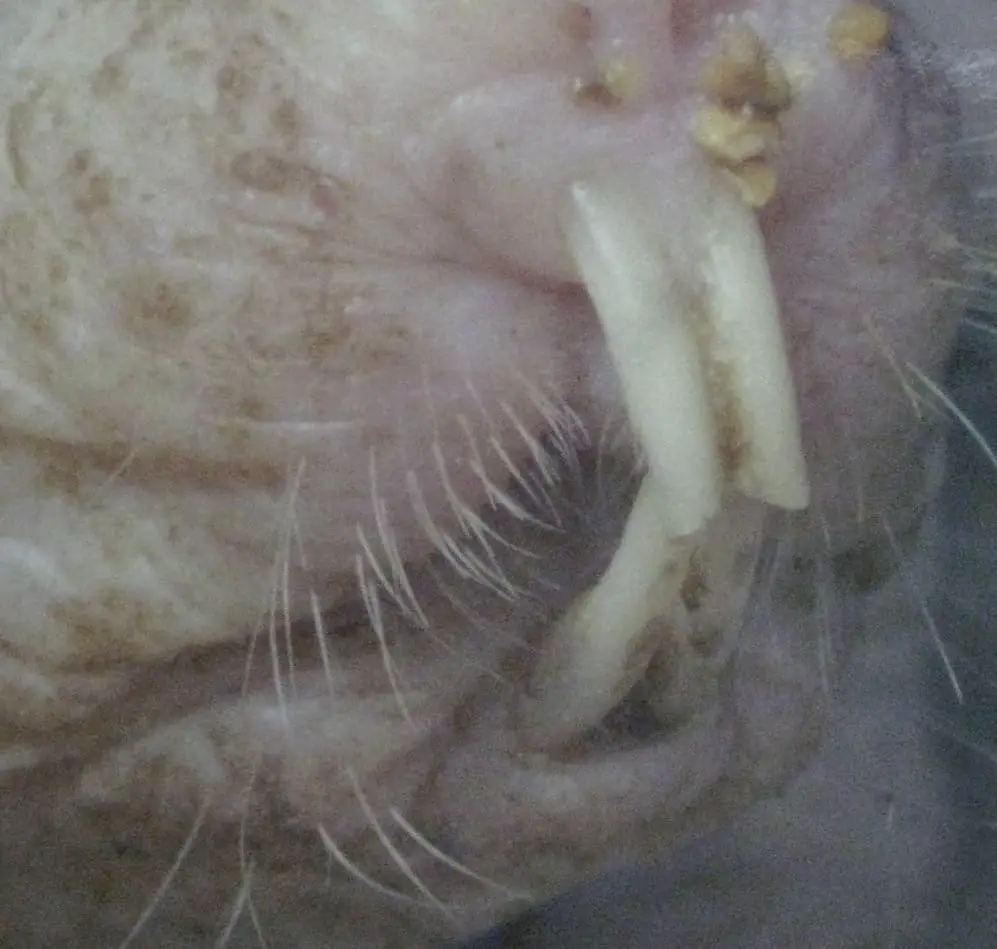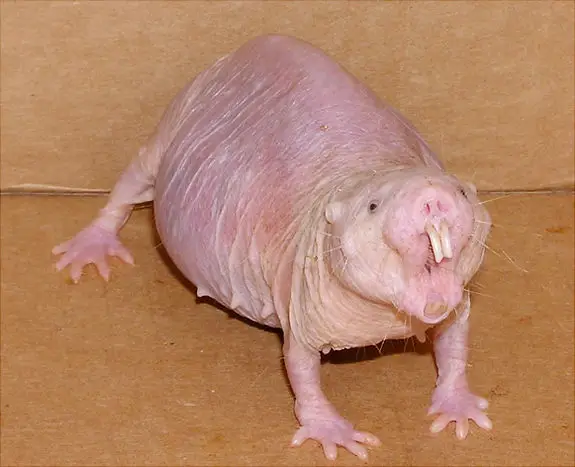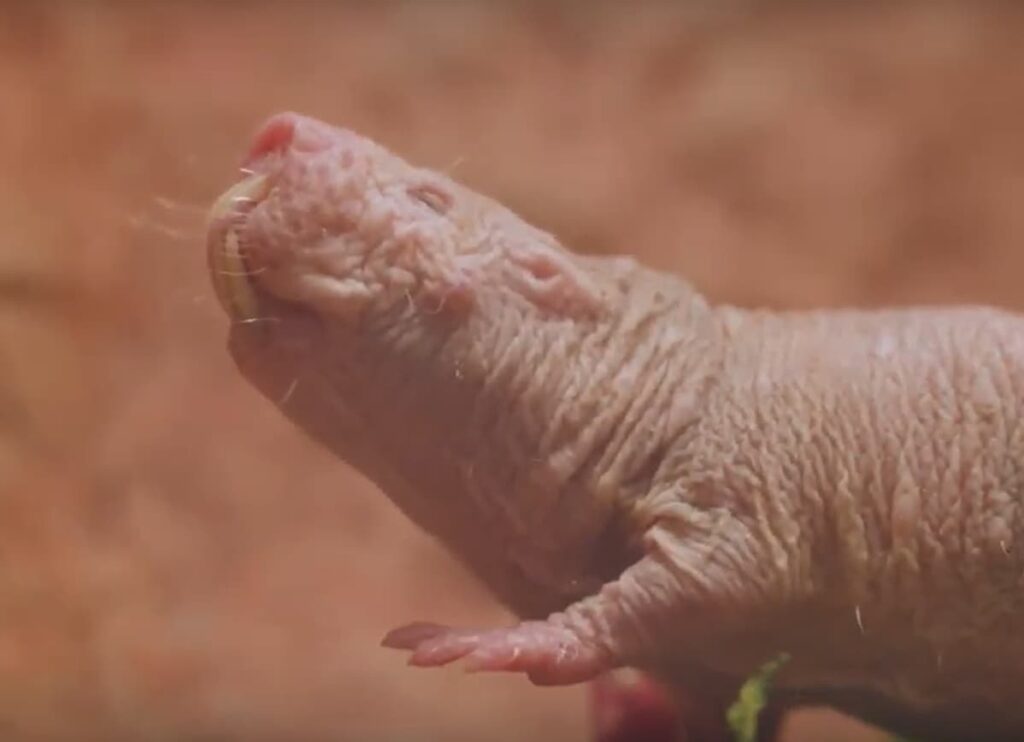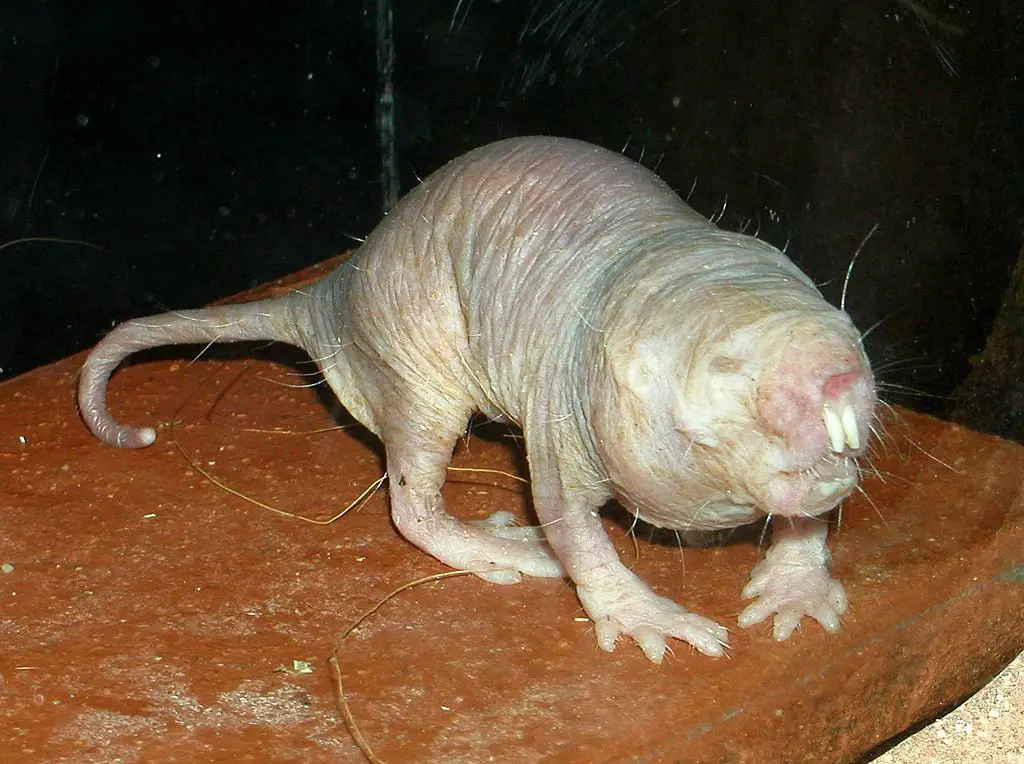Naked mole rats are not entirely blind, but they have very limited vision. Even though naked mole rats are rodents (mammals) they have a social structure that resembles that of insects living in hives or colonies. They have an eerily slow metabolism, cold blood like a reptile, and can survive without oxygen for up to 18 minutes. The queen is not born into the role, she must fight her way to the top. Once she makes it as queen, she must watch her back every day as her daughters take turns trying to murder her. The successful one takes over as queen and gets mating rights.
Naked mole rats are neither moles nor rats, despite their names, and are not totally naked. They are most closely related to guinea pigs and porcupines. They are long lived, having a 30-year lifespan, considered a record for a rodent and 10 times longer than rats and mice.
Naked mole rats are not particularly attractive with their buckteeth and lack of hair (some would say they’re downright ugly). Simply put, naked mole rats are bizarre.
These rodents have such a difficult life that they have evolved to save energy by allowing their body temperature to fluctuate with the ambient temperature. They can also survive in an environment that would suffocate humans and most other mammals because of high levels of carbon dioxide and little oxygen.
According to some scientists, “They might as well be from another planet.” They have a social structure that is similar to an insect’s and a metabolism that is similar that of a plant.
Why do Naked Mole Rats Live in Colonies?
A single naked mole rat doesn’t have a chance of finding enough food because the roots they rely on are widely dispersed.
Therefore, naked mole rats have evolved to live in colonies with a large workforce that vastly improves the odds of survival for each individual. Their enormous nests resemble those of ants, bees, and termites.
To survive the close confines of their colonies, naked mole rats have evolved a rigid social structure that is like that of insects (eusocial). Their respective roles are clear cut and distinct, with soldiers, workers, and one queen per colony.
Mole rats are the only mammals that exhibit eusocial behavior. Eusociality, a form of hierarchical social organization, is more frequently observed in ants and wasps than in other types of animals.
Naked mole rats spend their entire lives underground. Each colony has a single queen and a small number of consorts, served by hundreds of workers. They excavate miles of tunnels in search of underground tubers.
The colonies, which can house up to 300 mole rats, have elaborate underground tunnel networks, nest chambers, and communal restrooms. The average colony size is about 80 mole rats.
One drawback of such large numbers is the lack of oxygen inside their tunnels and excess carbon dioxide. Other subterranean mammals do not live together in such large numbers because they cannot survive the oxygen deprivation and acidity brought on by high carbon dioxide levels.
Soldier mole rats protect the colony from both predators, primarily snakes, and foreign mole rats, which they can smell from a distance.
Celibate worker mole rats spend most of their time digging, as well as taking care of all the other work in the colony, such as tending to the nursery, finding tubers to eat, and watching over the den.

Did I mention digging?
Studies in Kenya have shown that naked mole rats live in extremely hard soils – so hard that you can hardly dig it up with a pick.
Consequently, they dig with their front teeth unlike North American Gophers and moles which dig with their paws. Mole rats have lips that close behind their teeth to keep the dirt out of their mouths when they’re digging.

They dig in groups almost like a moving conveyor belt with a single animal at the front digging the dirt and a single animal at the back kicking the dirt out of a hole that looks like a volcano. All the other individuals, sometimes 15 or 20, form a line picking up soil from the digger ahead and kicking it behind them as they move backward toward the opening.
Once they’ve passed the dirt to the one behind, they straddle those below and move forward to take their place in the line once more.
How Does the Queen Rule Her Colony?
One Queen to rule them all,
– J.R.R. Tolkien, The Fellowship of the Ring
One Queen to find them,
One Queen to bring them all,
and in the darkness bind them.
In the naked mole rat colony, there’s only one ruler: THE QUEEN. She who must be obeyed.
The queen oversees every aspect of the colony’s life, putting herself first and attacking, intimidating, and often killing any other female who dares to try to mate, even if they are her daughters.
The only naked mole rats in the colony that get to mate are the queen and her very own harem of two to three males that she selects. (Is there a movie script here…or what!?)
The other naked mole rats of both sexes are either workers or soldiers who guard the colony against potential invaders.

The queen can rule for more than 20 years, which is an incredibly long time for a rodent, and during that time she might have a thousand offspring.
Once a female becomes queen, she must prevent all other females from becoming queen. This can be a bloody affair since challengers are always nearby ready to fight. And they are likely to be the queen’s own daughters!
It’s like a real life “Game of Thrones” starring naked mole rats; if you want to become queen, you must be prepared to assassinate the ruling queen.
Consequently, the queen must be larger, stronger, and fitter than her challengers.
The queen is noticeably longer than her subjects as the spaces between her vertebrae expand with pregnancy and age (no one knows how) to make room for more babies. By the time she’s fully stretched out she can bear up to 30 young in one litter.
Makes sense since she’s the only female reproducing in the entire colony.
It is quite the responsibility but, hey, whatever makes you happy! All in a day’s work if you’re the queen.
What do Naked Mole Rats Eat?
Naked mole rats eat root vegetables in the East African grasslands and deserts.
The tubers they search for can be like giant pumpkins, sometimes almost the size of bushel baskets. To find their food, the animals burrow blindly since the tubers don’t give off any telltale smells and, of course, they cannot be seen underground.
The tubers are far enough apart, and the soil is hard enough that a single mole rat trying to find one on its own would likely die before it succeeded. The only way to survive underground in this part of the world is to live in a colony and dig cooperatively.
Teams of workers are sent out to search for roots, and the entire colony shares what they find.
Once they find one of these bonanza tubers, they have enough food to last the colony for up to a month or more.
They’ve developed a smart strategy for making the tubers last longer. They bore through the middle, eating mostly the interior flesh and leaving the thin epidermis unharmed. With this behavior, the plant might be able to stay healthy and even continue to grow, giving the colony a reliable source of food in the long run.
Meanwhile, they continue to dig tunnels in search of the next tuber.
This lifestyle might not sound like our cup of tea, but it shows how perfectly adapted the naked mole rats are to surviving and thriving in a harsh environment where food resources are spread far and wide.
If they had to do it alone, without the colony, they would never make it before running out of food.
Physical Traits of Naked Mole Rats

Contrary to what you might have heard, naked mole rats are not blind. They have small eyes, however they don’t rely on them in their dark tunnels. Instead, they use whisker-like sensors on their tail, feet, and heads as navigation aids as they ‘feel’ their way in the dark.
Since they have such poor eyesight, the area of the brain used for visual processing has become reduced, and they utilize 30% more cortex for tactile processing.
Their brain organization has developed concurrently with their unusual physical and behavioral adaptations for their underground habitat, leading to an equally specialized and unusual brain adaptation.
They use chopstick-like teeth that can move independently to dig for roots and tubers. Their giant incisors are on the outside of their mouths so they can dig and chew without eating dirt.
They have wrinkly, loose skin like an oversize sweater that doesn’t tear when it catches on roots and other obstacles in their tunnel systems.
In those tunnels, the temperature is always high and muggy, averaging around 90 F (32 C) and up to 70% humidity. Being cold-blooded spares naked mole rats the trouble (and energy) of maintaining their body temperature.
Naked mole rats have excellent hearing and a keen sense of touch, and their nakedness protects them from parasites that would colonize a furry coat.
Naked mole rats have at least 18 different calls, each with its own meaning (we think), which is an unusual number for a rodent. Surprisingly, they sound like birds singing.
Can Naked Mole Rats Survive Without Oxygen?
Naked mole rats live in confined underground spaces where oxygen becomes depleted. Experiments have shown that naked mole-rats can endure hours of severe hypoxia (low oxygen) and up to 18 minutes of complete oxygen deprivation (anoxia) without showing any obvious signs of harm.
Mammals require a lot of oxygen because we use it to create the energy needed to keep our bodies at the proper temperature, to beat our hearts, and to move our muscles.
We would not last more than a few minutes without oxygen.
Naked mole rats have the ability to break down fructose, a sugar that can be used to generate energy without the use of oxygen.
Mammals typically metabolize glucose, a different sugar that produces more energy than fructose but that only functions when oxygen is present.
Naked mole rats have adapted to their low oxygen environment through natural selection.
- They’ve evolved a more efficient form of hemoglobin, the blood molecule responsible for carrying oxygen.
- Their hemoglobin is much ‘stickier’ than ours and can absorb oxygen even when it is in short supply.
- The naked mole-rat switches to anaerobic metabolism when anoxic conditions occur, and this metabolism is powered by fructose, which is actively accumulated and converted to lactate in the brain.
- In the event of a real oxygen emergency, naked mole rats can go into suspended animation. They stop moving, breathe more slowly, and their heart rate drops noticeably. As a result, they require significantly less energy and oxygen.
The ability to power their metabolism using fructose really sets these animals apart! No other mammal has this ability and it is more of plant-like characteristic.
The brain and heart cells of naked mole rats contain a large number of fructose pumps and enzymes that can metabolize fructose. These cells release fructose into the blood when they are severely oxygen-deprived.
Are Naked Mole Rats Cold Blooded?
Naked mole rats are the only mammals that cannot control their own body temperature in response to their environment, making them reptile-like in their cold-bloodedness.
This works for them because, for most of the year, the temperature underground in their tunnels stays near a constant 86 F (30 C).
Mole rats adapt to small temperature changes by moving between different chambers.
Do Naked Mole Rats Feel Pain?
Naked mole rats are not immune to pain. Doing so would be extremely dangerous given that pain serves as a warning sign for wounds. Instead, they appear to be able to dismiss some forms of inflammation that other animals, like us, find uncomfortable.
In addition to being able to survive in oxygen-free environments, research has shown that naked mole rats are also resistant to acid and capsaicin.
“We think evolution has selected for this tweak just subtly enough so that the pain signaling becomes non-functional, but not strong enough that it becomes a danger for the animal,” said lead author Gary R. Lewin, from the Max-Delbruck Centre for Molecular Medicine in Berlin (Omerbašić et al, 2016).
Lewin and his colleagues discovered that a small change in the TrkA receptor distinguishes the naked mole rat from other animals.
It appears that the evolutionary mutation in the TrkA receptors of naked mole rats causes them to feel pain at a level that is about one-third that of other rodents.
Here’s how the process works for most other animals – but not the naked mole rat.
Nerve growth factor (NGF) molecules bind to a receptor known as TrkA in response to high temperatures and inflammation around sensory neurons. A series of chemical signals are then released, “sensitizing” an ion channel on the surface of the sensory neuron called TRPV1 so that it opens. TRPV1 opens, which causes sensory nerves to fire and instructs the brain to register pain at otherwise non-painful temperatures.
The gene for the naked mole rat’s TrkA receptor was compared to those of 26 other mammals and five different species of African mole rats. On one section of the naked mole rat TrkA receptor, they found a switch of just one to three amino acid changes that reduces sensitivity.
The ability of the animal to feel pain is significantly impacted by the TrkA receptor, despite the fact that it is almost identical to that of a mouse or rat, according to the researchers.
The loss of sensitivity to heat may aid naked mole rats in surviving in their crowded underground colonies, where close contact can be uncomfortably hot. Additionally, it’s possible that adult animals who lose their sensory neurons do so to save energy.

Do Naked Mole Rats Get Cancer?
Only a few cases of cancer have ever been seen in captive animals, and they have a lifespan of 30 years or more.
According to the latest research, naked mole-rats have an exceptional resistance to cancer and can live for incredibly long periods of time due to specific bodily conditions that prevent the growth of cancer cells.
It was previously believed that naked mole-rats almost never developed cancer because their healthy cells were resistant to developing into malignant ones. However, University of Cambridge researchers have demonstrated that genes that can cause cancer in the cells of other rodents can also cause cancer in the cells of naked mole-rats (Hadi et al, 2020 in Nature).
The latest findings suggest that it is the micro-environment – the complex network of molecules and cells that surrounds a cell, including the immune system – that distinguishes naked mole-rats from other animals. In contrast to what was previously thought, the researchers now think that interactions with this microenvironment, not a cancer resistance mechanism within healthy cells, is what prevents the early stages of cancer from developing into tumors.
It was previously thought that healthy cells prevented the development of cancerous cells by self-destructing if they multiplied too quickly and posed a threat.
According to the Cambridge team, their research indicates that while tumors in naked mole rats are uncommon, their cells are no more intrinsically resistant to developing into cancer than cells from other animals.
Dr Ewan St John Smith from Cambridge University feels that the new research is important for tackling cancer. “If we understand why mole rats don’t get cancer, that opens up doors for us understanding news ways of potentially preventing cancer occurring in humans.”
Do Naked Mole Rats Show Signs of Aging?
Naked mole rats might look ugly, bald, and wrinkled from the day they are born, but at least they don’t get old and feeble.
Naked mole rats are the most resilient rodents we are aware of. Some naked mole rats are over 30 years old and still going strong, whereas mice and rats only live for a maximum of four to five years.
Additionally, they don’t appear to age according to the usual mammalian signs. The queen can bear children throughout her lifespan.
Scientists warn that we haven’t studied them for long enough to know when they naturally reach the end of their lifespan. However, despite slowing down as they age, they seem to be resistant to aging-related diseases like cancer and Alzheimer’s.
References
Omerbašić D, Smith ES, Moroni M, Homfeld J, Eigenbrod O, Bennett NC, Reznick J, Faulkes CG, Selbach M, Lewin GR.(2016) Hypofunctional TrkA Accounts for the Absence of Pain Sensitization in the African Naked Mole-Rat. Cell Rep. 2016 Oct 11;17(3):748-758. doi: 10.1016/j.celrep.2016.09.035. PMID: 27732851; PMCID: PMC5081396.
Hadi, F. et al (2020) ‘Transformation of naked mole-rat cells,’ Nature, July 2020. DOI: 10.1038/s41586-020-2410-x

